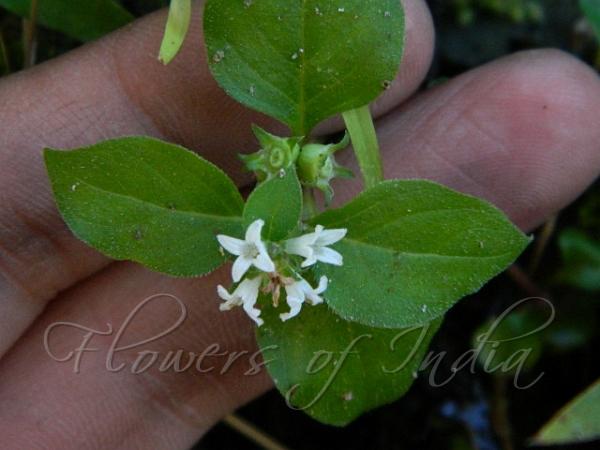|
| Hairy Starviolet |
|

|

| File size | 97010 |
| Original date | 10/19/11 11:08 AM |
| Resolution | 640 x 480 |
| Flash | Flash did not fire, auto |
| Focal length | 23.2mm |
| Exposure time | 1/160s |
| Aperture | 4.7 |
| Focus Distance | |
| Metering Mode | Multi-segment |
| Camera make | NIKON |
| Camera model | COOLPIX L120 |
| Sensor type |
|
|
|
|
Photo: |
Botanical name: Neanotis hirsuta Family: Rubiaceae (Coffee family)
Synonyms: Hedyotis hirsuta, Oldenlandia hirsuta, Oldenlandia japonica
Synonyms: Hedyotis hirsuta, Oldenlandia hirsuta, Oldenlandia japonica
Hairy Starviolet is a perennial herb, with lower stems
prostrate and upper stems apparently rising up. Flowers are borne at
branch-ends or in leaf-axils, in lax cymes, branched to 2 or 3 orders
often asymmetrically, with flowers borne separately or in glomerules of
2-5, hairless or hairy, carried on flower-cluster-stalk 0.8-3 cm.
Bracts are laciniate or stipuliform, 0.5-2 mm. Flowers are stalkless or
nearly so, white, funnel-shaped, outside hairless; tube 3.5-4 mm,
finely velvet-hairy, petals ovate to triangular, 2.2-3 mm. Sepal-cup is
hairless to densely hairy, limb divided essentially to base; sepals
linear-lanceshaped, 1-2 mm. Stems are round to 4-angled, hairless to
hirtellous in lines or throughout, angles sometimes thickened.
Leaf-stalks are 1-5 mm, leaves drying papery, ovate, lanceshaped, or
elliptic, 1-5.5 x 0.5-2 cm, above hairless or sparsely to moderately
bristly, rough or hairy, below densely hairy or hairless, base rounded
to wedge-shaped, tip pointed; secondary veins 3-5 pairs; stipules
rounded to triangular, 1-2 mm. Capsules are compressed spherical, 2-2.5
x 2.5-3 mm, hairless to hairy. Hairy Starviolet is found in wet sites
at streamsides or in forests, in Tropical & Subtropical Asia, including
the Himalayas and NE India, at altitudes of 500-2400 m. Flowering:
June-October.
| Identification credit: J.M. Garg | Photographed in Dalhousie, Chamba distt, Himachal Pradesh. |
• Is this flower misidentified? If yes,